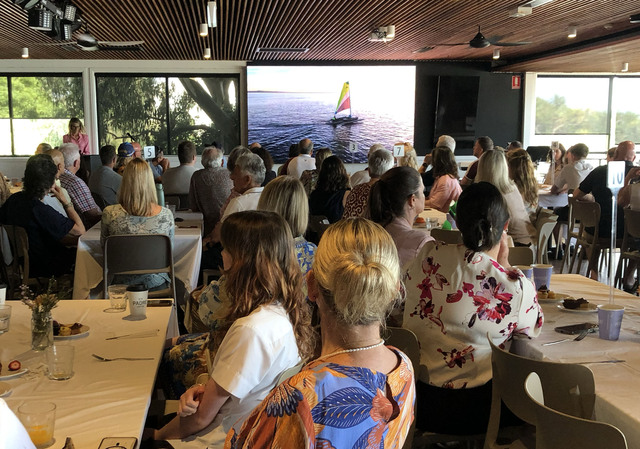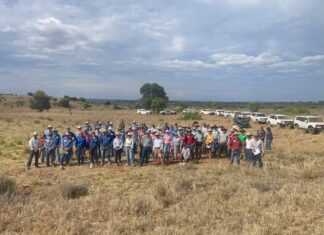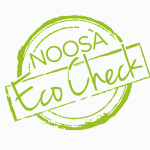
The Seahorse Inclusion Foundation was founded in 2024 with a simple and powerful purpose to remove barriers and create inclusive access to Noosa beaches and the community for people of all abilities and all backgrounds, Noosa Councillor Amelia Lorentson told guests at the foundation’s World Inclusion Day fundraising breakfast last Friday.
One of a small group of people who initiated the foundation, Cr Lorentson said the idea for it grew out of the Seahorse Nippers program at Noosa Heads Surf Life Saving Club (NHSLSC), which has for over a decade given children with disabilities the chance to enjoy the beach and learn vital water safety skills, and the desire to help two Seashorse Nipper families in need.
Last year they held their first fundraiser and through the generosity of the community were able to provide the two families, whose small cars could no longer transport their children’s mobility equipment, with accessible vans, as well as purchasing a beach wheelchair now available through Tourism Noosa’s Visitor Information Centre.
One of last year’s recipients Libby Doherty, mum to Seahore Nipper Daisy, told how the accessible van had been “life changing” for her and Daisy and the other family of five kids.
“Those vans have meant freedom, the ability to attend school, sport, the beach and to simply live our daily lives with independence and dignity,” she said.
“It means we can join in rather than watch from the sidelines. And for the other family it means all five kids can travel together safely and share experiences that bring them together closely as a family, things that some of us might take for granted.
“Inclusion isn’t just about ramps and equipment, it’s about belonging. It’s knowing that families like ours aren’t on the outside looking in but side by side, part of this community.”
This year funds were aimed at helping launch NHSLSC’s new pilot surf education program that will bring students from the remote areas of Cunnamulla and Morven to Noosa for a five-day surf lifesaving experience, to learn ocean awareness, safety and lifesaving skills and be mentored by Noosa surf life savers.
The fundraising event heard from several speakers including Surf Life Saving Queensland (SLSQ) CEO David Whimpey, NHSLC Cherbourg Program founder Jack Lewis, YoungCare chief CEO and former Noosa Mayor Clare Stewart and representatives from Noosa Tigers AFC Inclusion Team, Sunshine Butterflies, Noosa Flexi School and Sunshine Beach State High School (SBSHS).
Mr Whimpey said SLSQ which only began allowing women to patrol 45 years ago now put inclusion into the heart of what they do, but their core business remained saving lives.
“Since 1908 we’ve saved 165,000 lives. Every year we do 750,000 preventable actions, 65,000 first aids and give up 340,000 hours of patrolling,” he said.
In moving toward inclusion SLSQ has been developing programs in areas including women in leadership, youth, indigenous SLSC sport development, LBGTQI +, adaptive surf sports and adaptive nipper programs with 41 per cent of Queensland clubs now using beach wheelchairs and a quarter having beach mats.
“It is female leaders that are so inspirational, the narrative has changed, the way we feel about inclusivity has changed,” he said.
Noosa Flexi School student Riley told how the school’s flexible program supported individual students in their personal endeavours and how it was the small things that counted the most.
“It’s little gestures, a simple hello, a conversation,” he said.
SBSHS principal Anthony Swann said his school placed a high focus on removing barriers that prevent children reaching their potential.
“When you do that you build self worth, you build value. All students should have that feeling of value and worth in their lives. Inclusion more broadly it creates a better society,” he said.
Ms Stewart told the story of Youngcare which was started by David Conry and three mates who decided to build a place to care for David’s wife Shevaune, who was, at the time aged in her 30s, had multiple sclerosis and could no longer be cared for at home.
There was no place for Shevaune apart from aged care, Ms Stewart said.
After the story of Youngcare aired on television program 60 minutes, 7500 people came forward to say they were also in that situation, and government’s reacted to the spotlight it put on young people in aged care.
In the past 20 years Youngcare has built more than 20 disability homes for over 100 people and given away $12.2 million in grants to help more than 2000 people, Ms Stewart said.
Despite advances in inclusion Ms Stewart revealed statistics showing only 56 per cent of people of working age with a disability were employed compared to 82 per cent of people without a disability and a comparison of median wage incomes showed people with a disability earned only $575 a week while those without a disability earned $1055 a week.
Ms Lewis spoke about the NHSLSC Cherbourg surf education program that was initiated in 2018 in response to socio-economic data released in that year that showed Cherbourg, two hours from Noosa, was the most disadvantaged area in the whole of Australia based on income, education, employment, housing conditions.
Over the years the program has been expanded from swimming lessons being organised in Cherbourg pool to bringing Year 6 students to Noosa to take part in a surf education program.
Mr Lewis said the benefits included seeing the kids enjoying the ocean, giving them an insight into life outside of Cherbourg and the value the Cherbourg community placed on the program.






